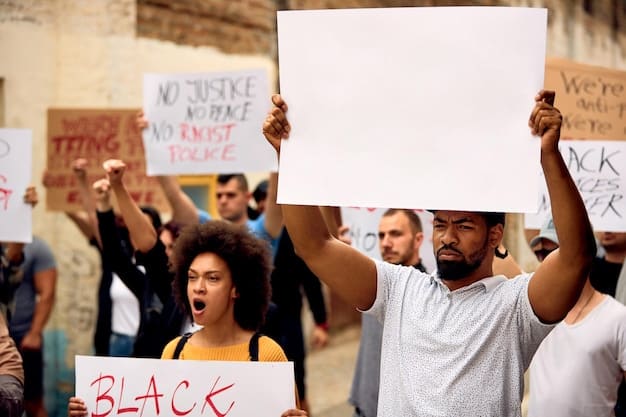Critical Race Theory: Impact on Racial Justice Discourse in 2025

Critical Race Theory (CRT) is expected to continue shaping discussions on racial justice in 2025 by providing a framework to analyze systemic racism, influence policy debates, and drive advocacy for equitable outcomes in various sectors.
The landscape of racial justice discourse is constantly evolving, and in 2025, the role of Critical Race Theory in Shaping Discussions About Racial Justice in 2025 is anticipated to be significant. Understanding how this academic framework influences policy, advocacy, and public opinion is essential for anyone engaged in these crucial conversations.
Understanding critical race theory
Critical Race Theory (CRT) emerged in the late 20th century as a critical examination of how race and racism have shaped legal systems and societal structures in the United States. Originating in the field of law, CRT challenges traditional approaches to racial equality by asserting that racism is not merely the product of individual bias or prejudice but is systemic and embedded in institutions.
At its core, CRT proposes that racism is a social construct used to maintain the power and privilege of dominant groups. It examines how laws, policies, and practices perpetuate racial inequality, even in the absence of overt discriminatory intent. By analyzing these structural elements, CRT seeks to uncover and address the underlying causes of racial disparities.

Key tenets of critical race theory
Several key tenets underpin Critical Race Theory, providing a foundation for its analysis and critique of racial dynamics:
- Intersectionality: Recognizes that race intersects with other identities such as gender, class, sexual orientation, and disability, creating unique experiences of discrimination and oppression.
- Critique of colorblindness: Challenges the notion that ignoring race will lead to equality, arguing that colorblindness can perpetuate existing inequalities by failing to acknowledge and address historical and ongoing racial disparities.
- Narrative and storytelling: Values the lived experiences and perspectives of people of color, using storytelling as a tool to challenge dominant narratives and promote understanding of racial injustice.
Critical Race Theory’s emphasis on systemic racism and the importance of historical context provides a framework for understanding how racial inequality persists in contemporary society. By examining the intersection of race, power, and law, CRT aims to dismantle structural barriers and promote a more just and equitable society.
The ongoing debate surrounding CRT
Critical Race Theory has become a focal point of intense debate in recent years, particularly in the United States. While proponents see CRT as a valuable tool for understanding and addressing systemic racism, critics argue that it promotes division, blames individuals for societal problems, and is inherently anti-American.
One of the main criticisms of CRT is that it essentializes race, reducing individuals to their racial identity and ignoring other aspects of their identity and experience. Critics argue that this can lead to stereotyping and discrimination, undermining efforts to promote unity and understanding. Furthermore, some argue that CRT’s focus on systemic racism downplays the role of individual agency and responsibility, creating a sense of victimhood and preventing people from taking personal responsibility for their lives.
Political and social polarization
The debate surrounding CRT has become highly politicized, with conservative politicians and media outlets often portraying it as a dangerous and divisive ideology that seeks to indoctrinate children and undermine traditional American values. In response, many states have introduced legislation to restrict or ban the teaching of CRT in schools and government institutions, sparking protests and legal challenges.
Conversely, supporters of CRT argue that these efforts to silence discussions about race and racism are a form of censorship that perpetuates ignorance and inequality. They contend that CRT provides a necessary framework for understanding the complex dynamics of race and power in society and that banning it from schools deprives students of the opportunity to engage with critical perspectives and develop a deeper understanding of American history.
The ongoing debate surrounding CRT reflects deep divisions in American society over issues of race, identity, and social justice. As the debate continues to unfold, it is important to engage with diverse perspectives and approach the issue with a commitment to open dialogue and critical thinking.
CRT’s influence on racial justice advocacy in 2025
Despite the controversies surrounding Critical Race Theory, its influence on racial justice advocacy is projected to remain significant in 2025. CRT provides activists and organizers with a powerful framework for analyzing and challenging systemic racism, informing strategies for policy reform, community mobilization, and social change.
One of the key ways that CRT influences racial justice advocacy is by highlighting the importance of addressing structural barriers and institutional practices that perpetuate racial inequality. Rather than focusing solely on individual acts of discrimination, CRT encourages advocates to examine how laws, policies, and institutions contribute to racial disparities in areas such as education, employment, housing, and criminal justice.

Impact on policy debates
In 2025, CRT is expected to continue shaping policy debates on a wide range of issues related to racial justice, including:
- Criminal justice reform: Advocates will likely use CRT to challenge racial profiling, discriminatory sentencing practices, and other aspects of the criminal justice system that disproportionately impact communities of color.
- Education equity: CRT can inform efforts to promote equitable funding for schools, address achievement gaps, and challenge curriculum that marginalizes the experiences and perspectives of students of color.
- Housing and urban development: CRT has been used to address discriminatory housing policies, redlining, and other practices that contribute to residential segregation and inequality.
By providing a critical lens for analyzing these issues, CRT empowers advocates to develop targeted strategies for addressing systemic racism and promoting equitable outcomes.
Potential challenges and limitations
While Critical Race Theory offers valuable insights and tools for advancing racial justice, it also faces several potential challenges and limitations. One of the key challenges is the risk of oversimplifying complex issues and reducing individuals to their racial identity.
Critics argue that CRT can sometimes neglect the diversity of experiences within racial groups, ignoring differences in class, gender, sexual orientation, and other factors that shape individual outcomes. This can lead to a one-dimensional understanding of race and limit the effectiveness of advocacy efforts.
Navigating nuanced perspectives
Another challenge is the potential for CRT to alienate or marginalize individuals who do not share its perspectives or assumptions. Some people may feel excluded or blamed by CRT’s critique of systemic racism, leading to defensiveness and resistance. To avoid these pitfalls, it is important for advocates to:
- Engage in respectful dialogue: Create space for open and honest conversations about race and racism, listening to diverse perspectives and acknowledging the complexity of the issues.
- Focus on shared goals: Emphasize common values and objectives, such as promoting fairness, equality, and opportunity for all, rather than focusing solely on divisive issues.
- Acknowledge individual agency: Recognize that individuals have the capacity to make choices and take actions that contribute to or challenge systems of oppression.
By addressing these challenges and limitations, advocates can harness the power of CRT to advance racial justice while avoiding the pitfalls of oversimplification and division.
The role of education and public discourse
Education and public discourse play a crucial role in shaping perceptions and understandings of Critical Race Theory. As CRT continues to be a subject of debate and controversy, it is important for educational institutions and media outlets to provide accurate and nuanced information about its principles and applications.
One of the key ways to promote understanding of CRT is to create opportunities for students and community members to engage with primary sources and scholarly research on race and racism. This can help people develop a deeper appreciation for the historical context of CRT and its relevance to contemporary issues.
Promoting informed discussions
Educational institutions can also facilitate informed discussions about CRT by:
- Inviting guest speakers: Bring in experts on CRT to lecture and lead discussions on its key concepts and applications.
- Offering courses and workshops: Develop courses and workshops that explore CRT in depth, providing students with the tools to critically analyze race and racism.
- Encouraging research and scholarship: Support faculty and students in conducting research on CRT and its impact on various fields.
By creating a culture of inquiry and critical thinking, educational institutions can help people develop a more nuanced and informed understanding of CRT. Media outlets also have a responsibility to report on CRT accurately and responsibly, avoiding sensationalism and misrepresentation. By providing a platform for diverse voices and perspectives, media outlets can contribute to a more balanced and constructive public discourse on race and racism.
Looking ahead: CRT and the future of racial justice
As we look ahead to 2025 and beyond, Critical Race Theory is likely to remain a significant force in shaping discussions about racial justice. While the debates surrounding CRT may continue, its influence on policy, advocacy, and public discourse is unlikely to diminish.
One of the key challenges facing racial justice advocates in the coming years will be to effectively communicate the principles and applications of CRT to a wider audience. This will require:
- Simplifying complex concepts: Translating academic jargon into plain language that is accessible to the general public.
- Providing concrete examples: Illustrating how CRT can be used to address real-world problems and improve people’s lives.
- Building bridges: Connecting with individuals and groups who may be skeptical or resistant to CRT, finding common ground and building alliances.
By addressing these challenges and engaging in open and honest dialogue, advocates can harness the power of CRT to advance racial justice and create a more equitable and just society for all.
| Key point | Brief Description |
|---|---|
| 💡Systemic Racism | CRT analyzes how racism is embedded in institutions, not just individual bias. |
| ⚖️ Policy Reform | CRT informs strategies for policy changes in criminal justice, education, and housing. |
| 🗣️ Public Discourse | Education and media play a crucial role in shaping understanding of CRT. |
| 🤝 Intersectionality | CRT recognizes the intersection of race with other identities. |
FAQ
▼
CRT posits that racism is systemic and embedded in institutions, not just individual bias. It examines how laws and policies perpetuate racial inequality.
▼
CRT provides a framework to analyze structural barriers and advocate for policy reforms in areas like criminal justice and education.
▼
Some critics argue that CRT essentializes race, promotes division, and diminishes individual agency by focusing too much on systemic issues.
▼
Education helps promote informed discussions about CRT by providing accurate information about its principles and applications in society.
▼
Advocates need to simplify complex concepts, provide concrete examples, and build bridges with those skeptical of CRT to foster understanding.
Conclusion
In 2025, Critical Race Theory in Shaping Discussions About Racial Justice in 2025 continues to be a vital framework for understanding and addressing systemic racism, shaping policy debates, and driving advocacy efforts for equitable outcomes in various sectors. While it faces challenges and criticisms, its influence on racial justice discourse remains significant.





